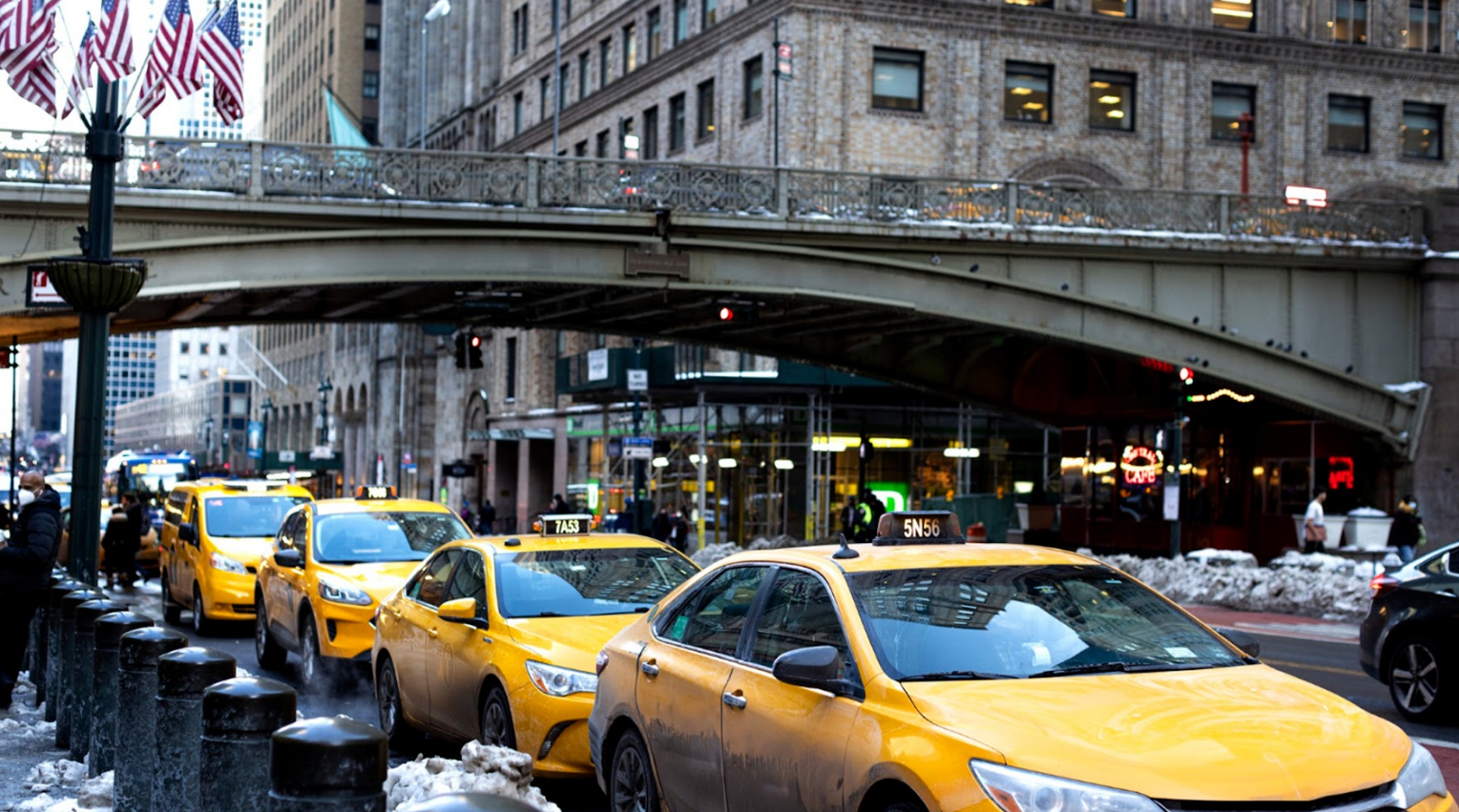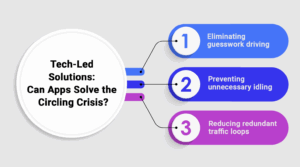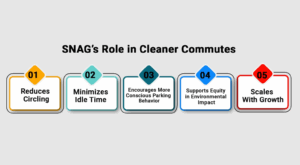
How Circling for Parking Impacts NYC’s Air Quality — Stats, Problems & the Best Parking App Fix
NYC Parking Stats: Time, Fuel & Air Quality Impact from Circling
It’s a scene as familiar to New Yorkers as yellow taxis and corner bodegas: a driver creeping along the block at 5 MPH, eyes scanning both sides of the street, hoping for a miracle. Multiply that by thousands, and you get the hidden epidemic quietly choking NYC’s air and wasting everyone’s time—circling for parking.
According to a study by INRIX, urban drivers in dense cities like New York spend an average of 107 hours per year just searching for parking. In NYC alone, that amounts to hundreds of thousands of collective hours spent slowly cruising through neighborhoods like the West Village, Crown Heights, and Jackson Heights with no guaranteed destination.
This real-world car circling parking stat reflects one of the most overlooked urban parking problems facing modern city infrastructure—and a major contributor to environmental decline.
On top of time lost, there’s fuel: researchers at UCLA found that cruising for parking can add up to 0.5 to 1.3 miles of driving per trip. For an average NYC driver, that’s thousands of excess miles per year. Gas prices aside, the environmental cost is far more alarming.
What starts as a 10-minute search for a street parking app user quickly becomes a systemic issue when scaled across millions of trips and millions of vehicles. It’s a death-by-a-thousand-cuts scenario where the real victim is the city’s environment.
The CO2 & Pollution Cost of NYC Parking: An Overlooked Urban Crisis
While much of the climate conversation in urban planning focuses on mass transit and renewable energy, circling for parking in NYC remains an underreported contributor to carbon emissions.
Let’s break it down:
- One gallon of gasoline burned releases roughly 19.6 pounds of CO2.
- An idling car (common when circling or double-parking) emits approximately 0.3 to 0.5 pounds of CO2 per minute.
- If a single vehicle spends 15 minutes a day circling for parking, it could produce over 27 pounds of CO2 per week, or nearly 1,400 pounds per year.
Even if only a quarter of NYC’s 2 million vehicles do this daily, these NYC parking stats point to hundreds of thousands of avoidable emissions annually—all from trying to find parking NYC residents need daily.
And the damage doesn’t stop with CO2. Circling contributes to:
- NOx emissions, worsening asthma and respiratory illness.
- PM2.5 pollution, which has been directly linked to increased mortality rates in urban neighborhoods.
- Increased noise pollution, caused by cars slowly idling in residential zones.
In areas like Chinatown, the Lower East Side, and parts of the Bronx, this issue is more than environmental—it’s deeply tied to public health disparities. The communities most exposed to circling traffic are often those with the least resources to address the consequences.
What Urban Planners Say About Circling, Parking Apps & Curb Demand
City planners, transit analysts, and environmental researchers have long warned that poor parking infrastructure worsens urban air quality. But what’s particularly problematic in New York is the mismatch between vehicle volume and curb space supply.
Donald Shoup, a renowned urban economist, argues that curbside parking scarcity creates a “cruising loop,” where drivers constantly circle blocks waiting for turnover. His studies showed that in some neighborhoods, as much as 30% of traffic congestion comes from drivers looking for parking—not heading to destinations.
In NYC, the data is equally revealing. According to NYC DOT reports:
- Certain Manhattan blocks see turnover rates of just 1.5 cars per hour.
- In high-demand areas, cars may pass the same block 3 to 7 times before finding a spot.
- Peak-hour cruising increases congestion by over 18% in zones like Midtown East and Downtown Brooklyn.
Even the city’s move toward open streets and expanded bike lanes—while environmentally beneficial—has reduced available curbside parking, intensifying the strain. Without a restructured approach to street parking, the circling crisis will only grow worse.
Urban planners now view parking demand management as essential to fighting climate change, not just improving traffic flow. And central to that strategy is the use of tech tools that reduce the need to circle in the first place.

Tech-Led Solutions: Can Apps Solve the Circling Crisis?
In the past decade, technology has radically changed how we commute, order food, and hail a cab. But street parking has remained frustratingly analog. Some apps claim to show available spaces using sensors or historic data—but these often lead to false hope and further circling.
What cities need are real-time, behavior-based systems that reflect how parking actually works. Instead of relying on guesswork, tech should focus on people-driven exchanges that reflect intent and action.
Apps like SNAG parking app, approach this differently. Instead of using sensors or cameras, SNAG connects two human beings: one leaving a space, and one looking for a space. This peer-to-peer interaction eliminates circling by replacing it with targeted, coordinated movement.
In effect, the app doesn’t just save time for users—it helps the environment by:
- Eliminating guesswork driving
- Preventing unnecessary idling
- Reducing redundant traffic loops
Unlike passive parking apps, SNAG is built around intentional coordination. This is what makes it the best parking app for climate-conscious commuters who want to skip the loop.
This approach shifts the parking experience from luck-based to intentional. That subtle difference can have massive implications for traffic, emissions, and urban sustainability.

SNAG’s Role in Cleaner Commutes
SNAG wasn’t built as a climate solution—but its impact goes far beyond finding spots. Here’s how Give a Spot SNAG helps improve the air and reduce congestion:
Here’s how:
1. Reduces Circling
When you snag a spot from a giver, you go directly to a location where someone is already waiting. You’re not circling, guessing, or hovering. That alone can shave 15-30 minutes off your search—and save the equivalent CO2 of a 2-mile drive.
2. Minimizes Idle Time
Traditional spot-hunting means slow creeping, stop-start movement, and long idling periods. SNAG eliminates that by replacing it with scheduled, real-time handoffs. Less idle = less emissions.
3. Encourages More Conscious Parking Behavior
SNAG prompts users to assess legality and spot type—free or metered—helping them avoid parking tickets in NYC.
4. Supports Equity in Environmental Impact
By reducing emissions from circling, SNAG indirectly improves air quality in neighborhoods disproportionately affected by pollution—often lower-income and frontline communities.
5. Scales With Growth
The more people join, the more efficient the car parking solutions NYC becomes. Each new user adds more potential spots, more real-time data, and greater distribution of drivers across neighborhoods. That growth leads to fewer duplicate loops and more precise movement.
SNAG isn’t pretending to overhaul New York’s entire transportation system. But it’s proving that even small, everyday shifts—like not circling for 20 minutes—can add up to major environmental wins.
Why Solving NYC’s Circling Crisis Needs Smart Parking Solutions Like SNAG
The circling crisis in NYC is more than an inconvenience—whether you’re using a street parking app, trying to find parking NYC, or just want to avoid driving in circles, the truth is clear: parking app NYC solutions like SNAG can help.
Parking doesn’t need to be a stress test or a smog-producing loop. With smart, intentional design and community-based apps like SNAG, we can connect drivers in real time, reduce unnecessary movement, and give the city’s lungs a break.
Clean air and less congestion don’t just come from infrastructure—they come from behavioral shifts powered by smart tools. If you want to be part of that shift, consider trying the SNAG parking app—the best parking app built for New Yorkers who are tired of circling.
